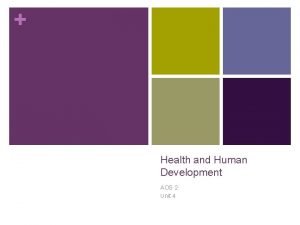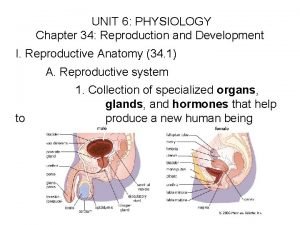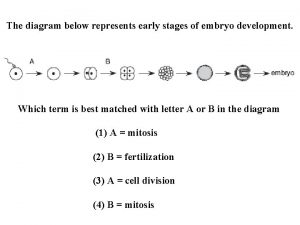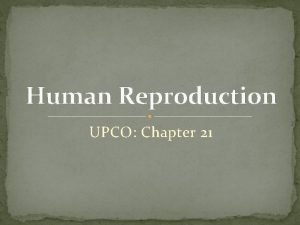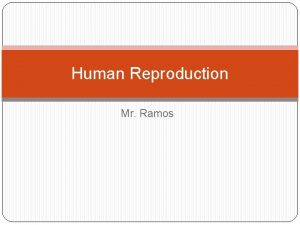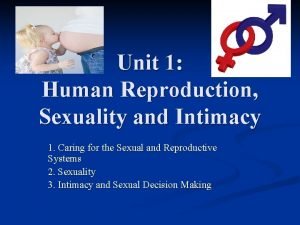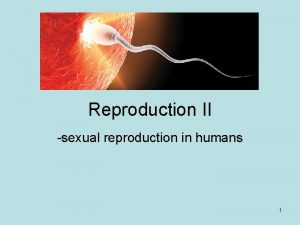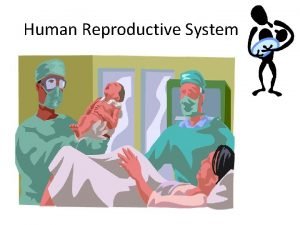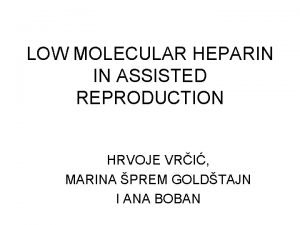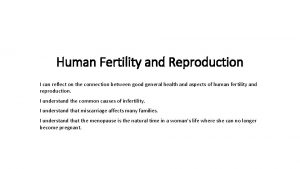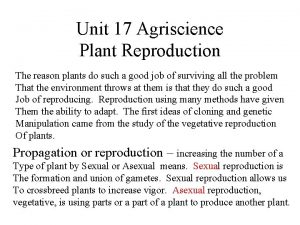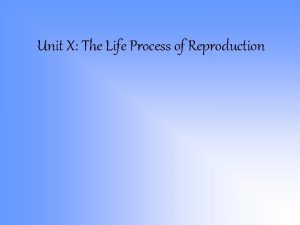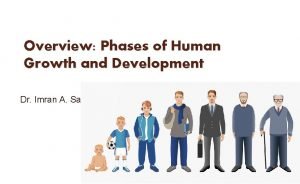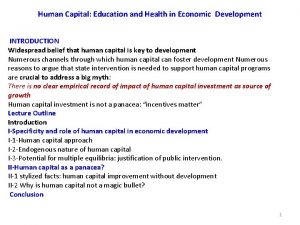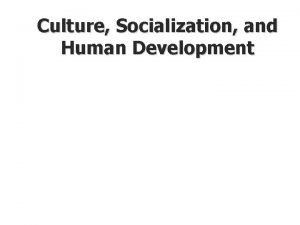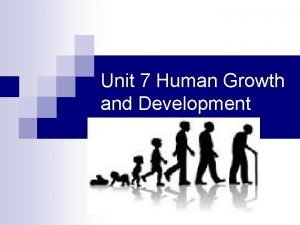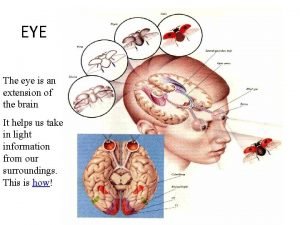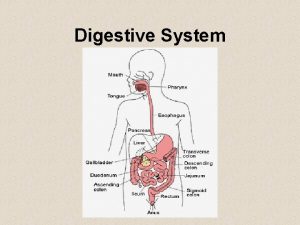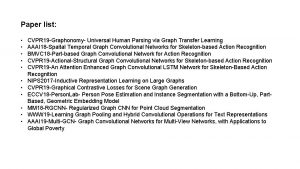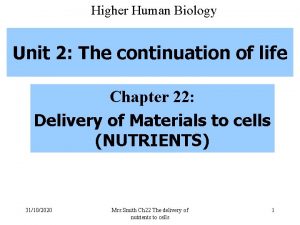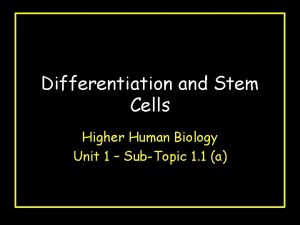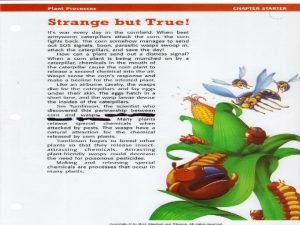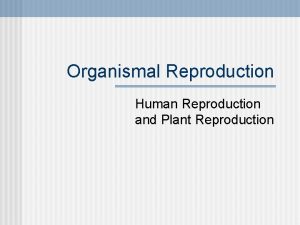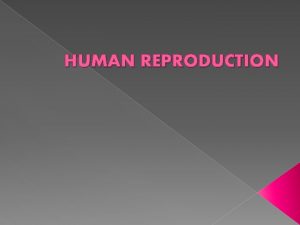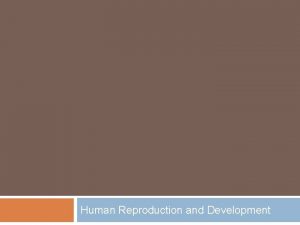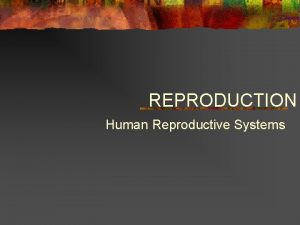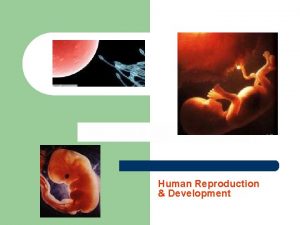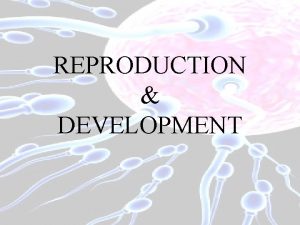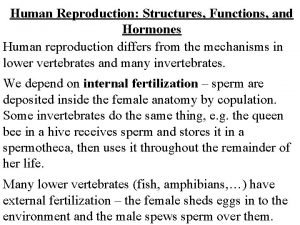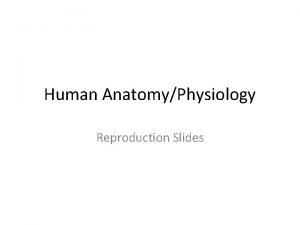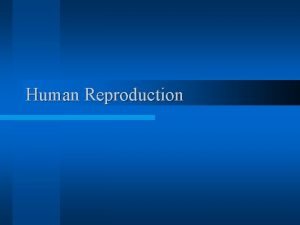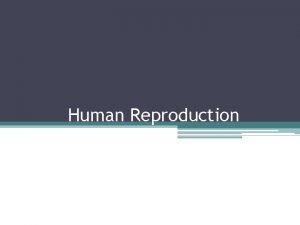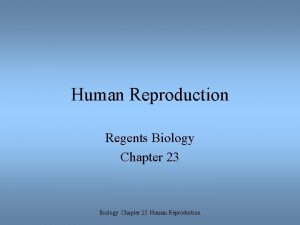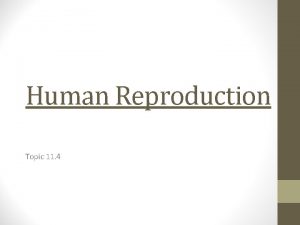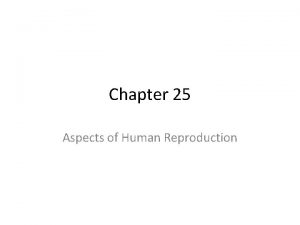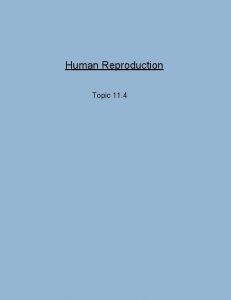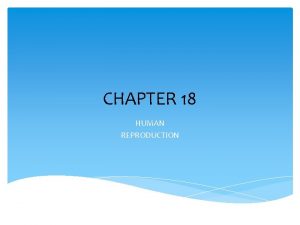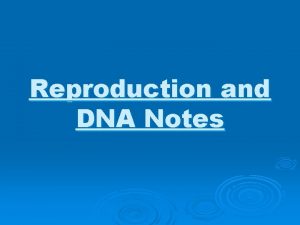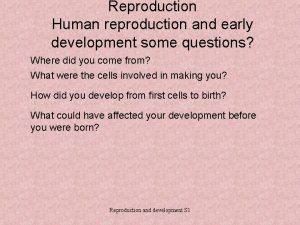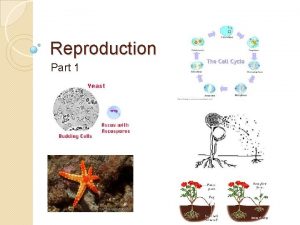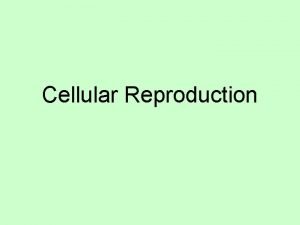UNIT 6 REPRODUCTION AND DEVELOPMENT PART 2 HUMAN































































- Slides: 63

UNIT 6 REPRODUCTION AND DEVELOPMENT PART 2 HUMAN DEVELOPMENT ZOOL-1072 Human Anatomy and Physiology

Assigned Reading This weekend � Review all of female reproduction and the development stuff we do today and come to class Monday with any questions or things that need to be clarified. Weeks 4 -8 Not heavily focused on so just get a general sense for the events. Read through the fetal period to see how a baby gets bigger. I will touch on this briefly on Monday. � Video Labor / Birth = FYI

INTRODUCTION Developmental Biology Study of events from fertilization formation of an adult organism

Developmental Biology – Key Terms Pregnancy: fertilization implantation embryonic development fetal development birth Obstetrics Prenatal development: time from fertilization until birth � Divided Embryo Fetus into three trimesters

Developmental Biology The embryonic period is from fertilization through the eighth week of development The fetal period begins at week 9 � and continues until birth The neonatal period covers � the first 28 days after birth

THE EMBRYONIC PERIOD From fertilization through the 8 th week

Embryonic Development – Week 1 • • Fertilization Cleavage of zygote Blastocyst formation Implantation

Fertilization For about seven hours after ejaculation, sperm are not capable of fertilization Capacitation prepares sperm for fertilization Fertilization occurs in ampulla of uterine tube 12 -24 hours after ovulation.

Fertilization At this stage, one capacitated sperm must penetrate the corona radiata and the zona pellucida Acrosomal enzymes and strong movements help with penetration

Fertilization Fusion of sperm cell with 2 o oocyte results in syngamy Syngamy prevents polyspermy Depolarization changes happen quickly

Fertilization Once a sperm cell enters a secondary oocyte, the oocyte must quickly complete meiosis II

Fertilization occurs as the genetic material (pronuclei) from the haploid sperm and haploid ovum merges to form a single diploid zygote.

Twins Dizygotic twins = fraternal � Two secondary oocytes released and fertilized by two different sperm Monozygotic twins = identical � Single fertilized ovum � Separation of developing cells into two embryos in first 8 days. � After 8 days = increased risk of conjoined twins

The Embryonic Period Cleavage is the rapid mitotic division of the zygote, starting the first week of development

The Embryonic Period Blastomeres � Day 2 = 4 cells � Day 3 = 16 cells 3 -4 days after fertilization a solid ball of cells forms called the morula � Day 4 -5 enters uterine cavity � Nourished by uterine milk

The Embryonic Period The morula develops into a blastocyst � At 32 cell stage Blastocyst differentiates into: � Trophoblast � Embryoblast � Internal fluid-filled cavity 7 -8 days after fertilization the blastocyst implants into the endometrium

The Embryonic Period – Summary of Week 1

The Embryonic Period Blastocyst implants within 24 days of reaching the uterine cavity (7 -8 days after fertilization) Endometrium in secretory phase. The blastocyst attaches to the endometrium oriented in such a way that the developing inner cell mass is directed toward the endometrium

Implantation As the blastocyst sheds zona pellucida, burrows its way in (secrete enzymes), the endometrium responds by becoming more vascularized and the endometrial glands enlarge After implantation, the endometrium is known as the decidua with three layers

Embryonic Development Week 2 TROPHOBLAST ~ 8 days after fertilization Develops into two layers Functions: � Secretes enzymes to help blastocyst implant � Secretes h. CG Sustains corpus luteum Peak secretion at 9 weeks when placenta is fully dev. Part of Chorion

Embryonic Development Week 2 BILAMINAR EMBRYONIC DISC DEVELOPMENT Embryoblast differentiates into: � Hypoblast (primitive endoderm) � Epiblast (primitive ectoderm) Enlarges to form amniotic cavity Forms the bilaminar embryonic disc

Embryonic Development Week 2 AMNION DEVELOPMENT Extraembryonic membrane # 1 Amnion forms as amniotic cavity enlarges As embryo grows, amnion surrounds it – creating the amniotic cavity

Embryonic Development Week 2 AMNIOTIC FLUID Cavity fills with amniotic fluid � Derived from maternal blood � Fetus contributes with urine Functions: � Shock absorber � Temp control � Prevents drying out � Prevents adhesions to surrounding tissues

Amniocentesis Procedure that samples amniotic fluid through a puncture of the amniotic sac � Sloughed-off fetal cells within the fluid can be sampled for chromosome defects Up to 350 abnormalities can be identified

Embryonic Development Week 2 YOLK SAC DEVELOPMENT Epiblast Extraembryonic membrane # 2 Amniotic Hypoblast forms the yolk sac. cavity Functions: � Transfers nutrients � Forms the mesoderm Yolk sac � Early source of blood cells � Forms part of the G. I tract Hypoblast � Produces gametes � Shock absorber � Prevents drying out of the fetus Meosderm

Embryonic Development Week 2 MATERNAL SINUSOID DEVELOPMENT ~ 9 th day - formation of lacunae (little lakes) ~ 12 th day - lacunae fuse = lacunar networks Endometrial capillaries around the developing embryo dilate = maternal sinusoids Synctiotrophoblast erodes sinusoids & endometrial glands maternal blood enters lacunar networks nutrients for blastocyst.

Embryonic Development Week 2 EXTRAEMBRYONIC COELOM DEVELOPMENT ~12 th day after fertilization, the extraembryonic mesoderm develops from yolk sac cells Mucus CT layer around the amnion and yolk sac forms = mesenchyme Several large cavities develop in the mesoderm and fuse to form the extraembryonic coelom

Embryonic Development Week 2 CHORION DEVELOPMENT Extraembryonic membrane # 4 Develops from: � Extraembryonic mesoderm + trophoblast layers Becomes the embryonic part of the placenta Protects embryo/fetus from mother’s immune responses: � Secretes proteins that block mother’s antibody production � Promotes T cell production to suppress the normal immune response in the uterus

Embryonic Development Week 2 CHORION DEVELOPMENT Inner layer of chorion fuses with amnion. Connecting stalk is future umbilical cord.

The Embryonic Period Week 3 The successive developmental stages discussed now results in the formation of �A trilaminar embryonic disc and � 4 extraembryonic membranes

Gastrulation Early formation of organs within the newly formed three germs layers

The Embryonic Period Week 3 The trilaminar embryonic disc develops into the 3 primary germ layers

The Embryonic Period Week 3 Ectoderm differentiates into the tissues of the brain and nerves, and the epidermis of the skin Mesoderm is a loosely organized connective tissue (mesenchyme) that matures to form blood, muscles, bones, and other connective tissue derivatives Endoderm gives rise to the epithelial lining of the digestive tract, respiratory tract, and several other organs; also the smooth endothelial lining of blood vessels Table 29. 1

• • • Ectoderm • Nervous tissue + arachnoid and pia maters Epidermis of skin + skin related components Eye + ear Epithelium of oral, nasal, anal cavities, sinuses, salivary glands • Melanocytes • Skeletal + CT components of head • All skeletal, cardiac and most smooth muscle • Cartilage, bone, CT • Blood, RBM, lymphatic tissue, blood + lymph vessels + Mesoder dura mater m • Dermis of skin and Fibrous / vascular tunic of eye • Mesothelium of thoracic, abdominal, pelvic cavities • Kidneys, ureters, adrenal cortex, gonads, genital ducts • Epithelium lining of GI tract, glands, and most organs of the Endoder urinary, reproductive and respiratory systems m • Gametes

The Embryonic Period Week 3 Hollow tube of cells = notochord process (day 16) Solid cylinder of cells = notochord (day 22)

The Embryonic Period 4 extraembryonic membranes: � Amnion � Yolk sac � Allantois � Chorion

Neurulation (Fig 29. 9) Mesodermal cells vertebral bodies. Ectodermal cells over the notochord form the neural plate. Neural plate neural folds + neural groove = neural tube Ectodermal cells (neural tube) form the neural crest � Nerves, ganglia, meninges, adrenal medullae, many skeletal + muscular parts of the head.

Neurulation The head of the neural tube develops into vesicles which become the parts of the brain.

Somites (Fig 29. 9) Blocks of mesoderm adjacent the neural tube. Precursor population of cells for dermis, skeletal muscle, cartilage, tendons & vertebrae. Between day 17 and the end of week 5, 42 -44 pairs of somites will develop.

Somites (Fig 29. 9) Each somite has three regions: � Myotome: develops into skeletal muscles � Dermatome: develops into CT and skin � Sclerotome: develops into vertebrae and ribs

Day 32 with 35 somites. The embryo is about 7. 0 mm in length. Note the indentations that are identified between somites.

Assigned Reading Development of the intraembryonic coelom Development of the cardiovascular system

The Embryonic Period The placenta is unique because it develops from two separate individuals, the mother and the fetus

The Embryonic Period The placenta is formed by the chorionic villi of the embryo and the decidua basalis of the endometrium of the mother

The Formation of the Placenta

The Formation of the Placenta

Placenta Functions: � Diffusion of O 2 + nutrients from mom to baby � Wastes diffuse from baby to mom � Protective barrier � Stores nutrients � Secretes hormones

Umbilical Cord Connection between embryo and placenta Develops from connecting stalk Consists of: � 2 umbilical arteries � 1 umbilical vein � Supporting mucous CT � Amnion layer

Assigned Reading Weeks 4 -8 � Not heavily focused on so just get a general sense for the events. Fetal Period � Read through these notes to see how a fetus gets bigger.

THE FETAL PERIOD

The Fetal Period The fetal period occupies the remainder of pregnancy, from the 9 th through the 40 th week

The Fetal Period For the fetus, very few new structures appear � Less vulnerable to damaging effects of drugs, radiation, microbes. The rate of fetal growth is remarkable Half full-term weight is added in last 2. 5 months! � Head becomes more proportionate. � By week 34 the fetus usually assumes an upside-down position in preparation for labor and delivery

Fetal Period From week 9 to week 38 See Table 29. 2 for a summary of changes during the fetal period

Face Development in the Womb http: //www. downvids. net/face-development-in-the -womb--1135703. html 9 months in the womb https: //www. youtube. com/watch? v=K 7 kaw 40 p. PYw

MATERNAL CHANGES DURING PREGNANCY

Secretion of h. CG First 3 -4 months, corpus luteum continues to secrete progesterone and estrogens. � Maintains uterine lining, prepares mammary glands. � Only slightly higher [ ] than a normal menstrual cycle After the 3 rd month, the placenta provides high levels of hormones. � Chorion secretes hormones into blood Human chorionic gonadotropin (h. CG) Relaxin Human somatomammotropin (h. CS)

Secretion of h. CG Mother makes the h. CG for the first ~ 12 weeks. Then the fetus (placenta) takes over. � If this transition doesn’t happen in time, the mother will abort. Months 3 -4 fetal placenta produces h. CG - stimulates corpus luteum � Prevents menstruation � Keeps embryo / fetus attached to uterine wall. Months 4 -5 h. CG levels drop sharply. Level off until birth. � Placenta is established. � Corpus luteum is no longer essential.

Production of CRH Corticotropin-releasing hormone was most recently found to be produced by the placenta. It’s the “birth clock” � Secretion begins ~ 12 weeks � Increases sharply towards end of pregnancy � If levels are too high too early = premature birth � Low levels = late delivery

Hormones of Pregnancy

Changes During Pregnancy Uterus enlarges Weight gain – increased nutrient storage Breast enlargement Lower back pain Increased SV, HR, BV, lowered BF and venous return Increased tidal volume, decreased expiratory reserve Increased appetite, decreased motility Pressure on urinary bladder Skin and hair alterations Increased vascularity of reproductive system

Embryonic Period Summary Major events: � Fertilization � Cleavage � Blastocyst formation � Implantation � Formation of the three primary germ layers � Formation of embryonic membranes Other important events to take note of: � Neurulation � Somite development � Development of chorionic villi and placenta Weeks 4 -8 = read through how a fetus gets bigger Pregnancy hormones (only what we talked about).

Diagrams to Note Week 1 Figure 29. 5 Week 2 Figure 29. 6 Week 3 Figure 29. 7 Germ layers Table 29. 1

Reminder Notes provided on labor and birth are FYI. You should know the big idea for the positive feedback loop for birth (oxytocin makes contractions harder and more frequent)
 Sexual reproduction and asexual reproduction
Sexual reproduction and asexual reproduction Sexual and asexual reproduction venn diagram
Sexual and asexual reproduction venn diagram Sexual asexual venn diagram
Sexual asexual venn diagram Hhd vcaa
Hhd vcaa Chapter 8 human needs and human development
Chapter 8 human needs and human development Chapter 8 human needs and human development
Chapter 8 human needs and human development Health and human development unit 4 aos 2
Health and human development unit 4 aos 2 Chapter 34 reproduction and development answer key
Chapter 34 reproduction and development answer key Human development index definition ap human geography
Human development index definition ap human geography The diagram below shows stages of human reproduction
The diagram below shows stages of human reproduction Human reproduction webquest
Human reproduction webquest Reproduction human
Reproduction human Introduction of human reproduction
Introduction of human reproduction Sexual reproduction in human
Sexual reproduction in human Reproduction human
Reproduction human Human reproductive system
Human reproductive system Male reproductive structure in plants
Male reproductive structure in plants Reproduction in human
Reproduction in human Human reproduction
Human reproduction Chapter 16 lesson 2 the male reproductive system
Chapter 16 lesson 2 the male reproductive system Unit 17 plant reproduction
Unit 17 plant reproduction Reproduction unit
Reproduction unit Unit 10, unit 10 review tests, unit 10 general test
Unit 10, unit 10 review tests, unit 10 general test Chapter 5 diversity and human needs and development
Chapter 5 diversity and human needs and development Part part whole addition
Part part whole addition Unit ratio definition
Unit ratio definition Part part whole
Part part whole Technical object description example
Technical object description example Footed wares example
Footed wares example The phase of the moon you see depends on ______.
The phase of the moon you see depends on ______. 미니탭 gage r&r 해석
미니탭 gage r&r 해석 Human nouns
Human nouns Lesson 6 trapezoids and kites
Lesson 6 trapezoids and kites Solving inequalities unit test part 1
Solving inequalities unit test part 1 Equations and inequalities unit test part 1
Equations and inequalities unit test part 1 Social changes in adulthood
Social changes in adulthood Theories on growth and development
Theories on growth and development Stages of human development
Stages of human development Important realities of the human person
Important realities of the human person Late childhood mental development
Late childhood mental development Human capital education and health in economic development
Human capital education and health in economic development Human development and socialization
Human development and socialization Physical quality of life index and human development index
Physical quality of life index and human development index Deped human resource development plan
Deped human resource development plan Social changes in late adulthood
Social changes in late adulthood Needs analysis example
Needs analysis example Society for human and environmental development
Society for human and environmental development Infancy psychosocial development
Infancy psychosocial development Voiding of bladder
Voiding of bladder Kidneys are part of the excretory system in a human body
Kidneys are part of the excretory system in a human body Quizlet
Quizlet Small intestine parts
Small intestine parts Cvpr paper list
Cvpr paper list Higher human biology unit 2 questions and answers
Higher human biology unit 2 questions and answers Higher human biology unit 1 questions and answers
Higher human biology unit 1 questions and answers Section 1 meiosis
Section 1 meiosis Unequal survival and reproduction that results from the
Unequal survival and reproduction that results from the Fragmentation asexual reproduction examples
Fragmentation asexual reproduction examples Chapter 10 sexual reproduction and genetics
Chapter 10 sexual reproduction and genetics Flowering plants are called?
Flowering plants are called? Lesson 20.2 the male reproductive system
Lesson 20.2 the male reproductive system Chapter 10 section 3 gene linkage and polyploidy
Chapter 10 section 3 gene linkage and polyploidy Sexual and asexual reproduction in animals venn diagram
Sexual and asexual reproduction in animals venn diagram Two types of reproduction
Two types of reproduction






